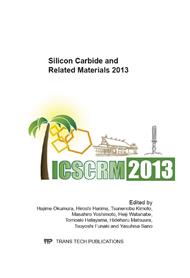p.495
p.499
p.503
p.507
p.513
p.517
p.521
p.525
p.529
Thin PSG Process for 4H-SiC MOSFET
Abstract:
The use of phosphorous as a passivating agent for the SiO2/4H-SiC interface increases the field effect channel mobility of 4H-SiC MOSFET to twice the value, 30-40cm2/V-s, that is obtained with a high temperature anneal in nitric oxide (NO). A solid SiP2O7 planar diffusion source is used to produce P2O5 for the passivation of the interface. Incorporation of phosphorous into SiO2 leads to formation of phosphosilicate glass (PSG) which is known to be a polar material causes device instability. With a new modified thin phosphorous (P) passivation process, as described in this abstract, we can improve the stability of MOSFETs significantly with mobility around 75cm2/V.s.
Info:
Periodical:
Pages:
513-516
Citation:
Online since:
February 2014
Price:
Сopyright:
© 2014 Trans Tech Publications Ltd. All Rights Reserved
Share:
Citation:


